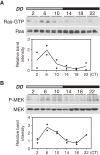Circadian clock-controlled diurnal oscillation of Ras/ERK signaling in mouse liver
- PMID: 23318682
- PMCID: PMC3611956
- DOI: 10.2183/pjab.89.59
Circadian clock-controlled diurnal oscillation of Ras/ERK signaling in mouse liver
Abstract
Accumulating evidence indicates that ERK MAP kinase signaling plays an important role in the regulation of the circadian clock, especially in the clock-resetting mechanism in the suprachiasmatic nucleus (SCN) in mammals. Previous studies have also shown that ERK phosphorylation exhibits diurnal variation in the SCN. However, little is known about circadian regulation of ERK signaling in peripheral tissues. Here we show that the activity of Ras/ERK signaling exhibits circadian rhythms in mouse liver. We demonstrate that Ras activation, MEK phosphorylation, and ERK phosphorylation oscillate in a circadian manner. As the oscillation of ERK phosphorylation is lost in Cry1/Cry2 double-knockout mice, Ras/ERK signaling should be under the control of the circadian clock. Furthermore, expression of MAP kinase phosphatase-1 (Mkp-1) shows diurnal changes in liver. These results indicate that Ras/ERK signaling is strictly regulated by the circadian clock in liver, and suggest that the circadian oscillation of the activities of Ras, MEK, and ERK may regulate diurnal variation of liver function and/or homeostasis.(Communicated by Shigekazu NAGATA, M.J.A.).
Figures




Similar articles
-
Ras Activity Oscillates in the Mouse Suprachiasmatic Nucleus and Modulates Circadian Clock Dynamics.Mol Neurobiol. 2016 Apr;53(3):1843-1855. doi: 10.1007/s12035-015-9135-0. Epub 2015 Mar 12. Mol Neurobiol. 2016. PMID: 25762011
-
Constitutive activation of ras in neurons: implications for the regulation of the mammalian circadian clock.Chronobiol Int. 2006;23(1-2):191-200. doi: 10.1080/07420520500521970. Chronobiol Int. 2006. PMID: 16687293 Review.
-
Circadian expression and functional characterization of PEA-15 within the mouse suprachiasmatic nucleus.Eur J Neurosci. 2018 Apr;47(7):845-857. doi: 10.1111/ejn.13850. Epub 2018 Feb 19. Eur J Neurosci. 2018. PMID: 29383758 Free PMC article.
-
Oxyntomodulin regulates resetting of the liver circadian clock by food.Elife. 2015 Mar 30;4:e06253. doi: 10.7554/eLife.06253. Elife. 2015. PMID: 25821984 Free PMC article.
-
Signalling entrains the peripheral circadian clock.Cell Signal. 2020 May;69:109433. doi: 10.1016/j.cellsig.2019.109433. Epub 2020 Jan 23. Cell Signal. 2020. PMID: 31982551 Review.
Cited by
-
MiR-27a-3p promotes the osteogenic differentiation by activating CRY2/ERK1/2 axis.Mol Med. 2021 Apr 26;27(1):43. doi: 10.1186/s10020-021-00303-5. Mol Med. 2021. PMID: 33902432 Free PMC article.
-
Loss of thyroid gland circadian PER2 rhythmicity in aged mice and its potential association with thyroid cancer development.Cell Death Dis. 2022 Oct 26;13(10):898. doi: 10.1038/s41419-022-05342-2. Cell Death Dis. 2022. PMID: 36284088 Free PMC article.
-
Diurnal suppression of EGFR signalling by glucocorticoids and implications for tumour progression and treatment.Nat Commun. 2014 Oct 3;5:5073. doi: 10.1038/ncomms6073. Nat Commun. 2014. PMID: 25278152 Free PMC article.
-
Static Magnetic Fields Regulate T-Type Calcium Ion Channels and Mediate Mesenchymal Stem Cells Proliferation.Cells. 2022 Aug 8;11(15):2460. doi: 10.3390/cells11152460. Cells. 2022. PMID: 35954307 Free PMC article.
-
Circadian rhythm of intracellular protein synthesis signaling in rat cardiac and skeletal muscles.Biochem Biophys Rep. 2016 Dec 23;9:153-158. doi: 10.1016/j.bbrep.2016.12.005. eCollection 2017 Mar. Biochem Biophys Rep. 2016. PMID: 28956001 Free PMC article.
References
-
- Reppert S.M., Weaver D.R. (2002) Coordination of circadian timing in mammals. Nature 418, 935–941 - PubMed
-
- Ko C.H., Takahashi J.S. (2006) Molecular components of the mammalian circadian clock. Hum. Mol. Genet. 15, R271–R277 - PubMed
-
- Hastings M.H., Reddy A.B., Maywood E.S. (2003) A clockwork web: circadian timing in brain and periphery, in health and disease. Nat. Rev. Neurosci. 4, 649–661 - PubMed
-
- Gachon F., Olela F.F., Schaad O., Descombes P., Schibler U. (2006) The circadian PAR-domain basic leucine zipper transcription factors DBP, TEF, and HLF modulate basal and inducible xenobiotic detoxification. Cell Metab. 4, 25–36 - PubMed
Publication types
MeSH terms
Substances
LinkOut - more resources
Full Text Sources
Other Literature Sources
Research Materials
Miscellaneous

